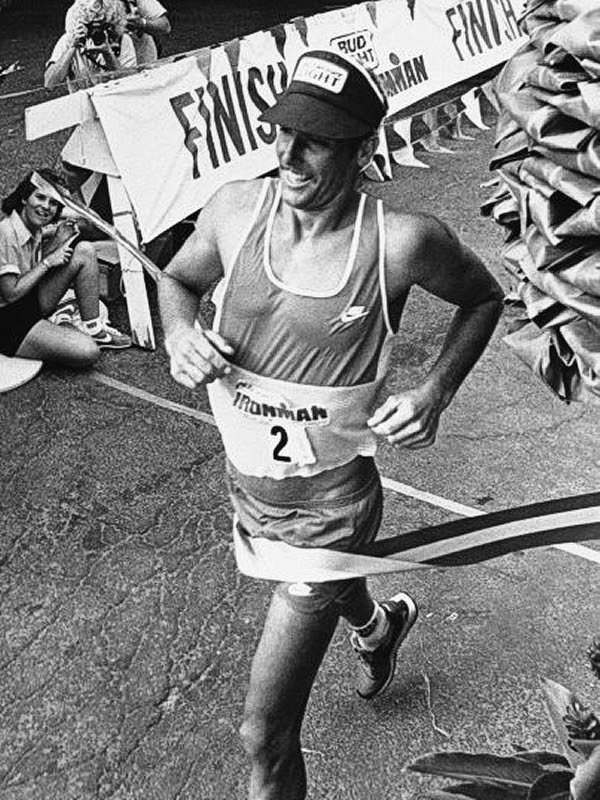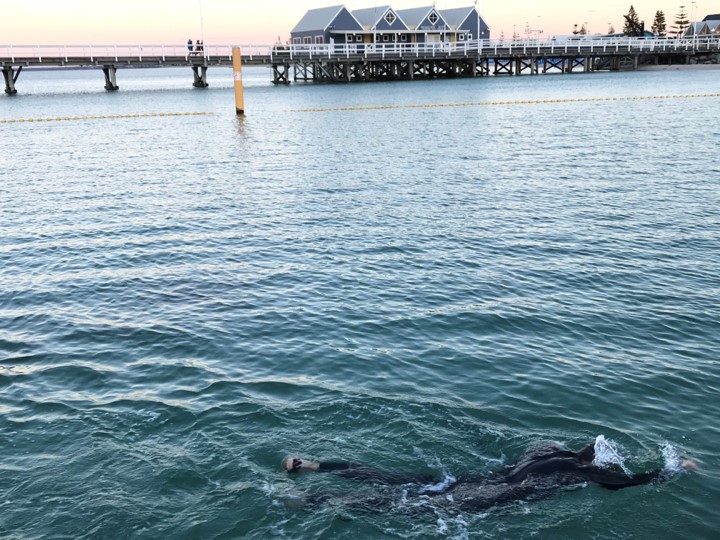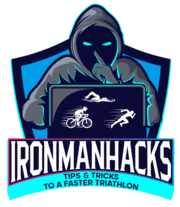
You may have heard that imagining the race in your mind beforehand, specifically seeing yourself cross the finish line, is something you should do if you want a good result.
It’s true, but it’s a lot more than that.
First of all, and maybe most important, is that you should concentrate on the part of the race that becomes the hardest. This is the end of the runs, especially in full Ironman races.
According to Tim Noakes, MD, “…usually after 80% to 85% of the activity has been completed, your conscious brain will ask you whether you should continue. This is the so-called stopping wish.”
“But if you still have a realistic chance of achieving your goal while you first experience the stopping wish, the chances are that you will continue.”
“In addition, if you have practiced mental imagery and visualized how you will respond to the stopping wish, you will be less likely to succumb to the dictates of your central governor.”
This is in page 541 of his excellent book, “Lore of Running.”
Dave Scott, whom we interviewed, told us something similar:
“People should have a mental roadmap of the race, not equidistant, but where the false flats are, windy sections, turns on the swim, landmarks to look at, and more. Know the course.”

“Have this mental roadmap and break the race up into races. Don’t look at the full race. Look at the mini races in it and quantify how to get there up around that corner or over that hill.”
Between what Noakes writes and what Dave suggests, there are a few ways we can do this.
Run
First, try to imagine the last 10-15k of the run. That part where your mind begs you to stop.
That part where you wonder why you can’t just walk a bit longer after that aid station.
That part where you convince yourself your race goal is unachievable.
How are you supposed to imagine it? First, you need to see it or experience it.
For sure, the best way is to actually go to the course and run it. Go there and try to replicate race conditions.
Do a slow run, following the pace you expect to do the race in. Try to do it at the estimated time of day you think you’ll race it in, too, if at all possible.
Pay attention to everything. Look at landmarks, the road surface, the skyline, and anything else notable.
Are there any slopes, corners, or rough surfaces? U-turns, bottlenecks, or intersections? Find them and remember them.
You’ll need to use all your senses. Look, listen, smell, feel.
Even wear what your race day kit and eat and drink what you’ll consume then, too.
Observe the weather, wind, sun, shadows. The more your senses can connect, the deeper your memories will be.
If you live near the course this is easy. Otherwise, you may be able to do this a day or two before the race, if you arrive early.
(See tip #19, Arrive at the race a few days early).
Cycling the run segment of the course will work too, but of course it’s not nearly as good of a simulator as running it. I’ve even driven the course, as explained in tip #18, Check the course before race day.
Another way of seeing the course is by watching video of it. I’ve done this on YouTube beforehand and by reading and watching race reports.
Bike
Although visualization is most critical to the end of the run, you may also want to ride the bike leg. Again, do it in the days before the race.
If you can’t ride the actual course you may be able to ride it virtually.
Rouvy is a great option. It has hundreds of courses in it for you experience.
Rouvy allows you to ride your home bike trainer and watch video of real triathlon courses from all over the world. Your avatar will be on the screen and the bike resistance will adjust based on hills.
Another way of riding a course is by simply uploading a GPS file of the course to your bike computer and doing it on the home trainer. Pair that with a YouTube video of the course and you’re in business.

I did this for the Nice bike of the 2019 World Championships. Paired with Wahoo’s Climb, I had an even better simulation as the front wheel height adjusted to mimic the hills.
However, the GPS upload approach is far from any visualization – it’s just a way to familiarize yourself with the hills. Won’t do much for a flat course.
Swim
I like to imagine the swim, too. I’ll always swim the course the day before the race, but this is a bit late to start imprinting that on my mind. If there’s any possible way of doing it weeks or months in advance, do it.
And before I imagine the swim, I’ll refer to the race guide to figure out how far out I have to go before the first corner.
Right or left corner?
U-turn or 90 degree?
Things like that.

Again, the senses play a huge role. Concentrate on things like water temperature and even taste and smell (tip #10), underwater visibility, landmarks on the shore, even the feel of the sand.
Is it fine, muddy, rocky, or what?
Are there currents? Waves? Wind?
Grab a mental picture of it all.
The Replay
Once you have this imprint, how do you replay it in your head?
I like doing this before going to sleep. Start with the last 10-15k of the race as it is most critical. (If I start with the beginning of the race, I usually will fall asleep before reaching the end.)
- Think positively. Do not think of yourself as being in a state of suffering, but being in a state of control and imminent [personal] victory!
- Consider your paces and times. If you have used our pace calculator in the app or the web version of the pace calculator, you will be able to not only estimate the total elapsed time but also the splits.
- Ensure you do this in a quiet place, in a relaxed state. Bed is great, but I have also done this in the sauna, steam room, and Jacuzzi, all alone.
- Layer on sounds of the crowd; tastes of the drinks; feel of the road.
- Have a purpose. “This visualization is to finish strong,” or “This imagery session is to be comfortable in those big waves,” or whatever.
- Finally, as a treat, go ahead and visualize the finish line. The cheering, the cowbells, the bright lights, the red carpet, and of course the booming voice of Mike Reilly telling you, “You are an Ironman!”
It will take a fair amount of effort and concentration to achieve all of this effectively. It is very difficult to visualize an entire triathlon properly, so doing it bit-by-bit is critical.
But it’s free, fun, and you can do it an unlimited number of times. This is a real hack as it is very likely to improve your race and build your mental game – the ultimate endurance superpower.
Related tips:
